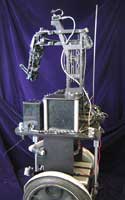Operating robots with virtual reality
Where the operator is on one side of the world and the robot the other, the delay prevents fine control and the robot has to be semi-autonomous. In addition, looking at a flat 2d image makes it hard to control a robot.
Some systems use stereoscopic video, such as the Airbus Military Aerial Refuelling Boom System (ARBS) fr the Airbus A330 Multi Role Tanker Transport (MRTT) aircraft being acquired by the Royal Australian Air Force. With this system the operator sits in the aircraft cockpit and fly the boom while looking at a stereoscopic image. Previous systems, such as the KC-135, require the operator to be in the tail of the aircraft. It might be interesting to enhance the Airbus system with virtual reality.
Teleoperation System with Supervisory Control in a Mixed Reality Environment
Bagus Manuaba (SoCS CECS)
CS HDR MONITORINGInfo & Human Centred Computing Research Group
DATE: 2010-04-15
TIME: 11:30:00 - 12:00:00
LOCATION: Ian Ross Seminar Room
CONTACT: Michelle.Moravec@anu.edu.au
ABSTRACT:
Mixed reality is a new innovation of virtual reality. By combine this innovation with supervisory control in teleoperation system is expected can solve any limitations that occur in teleoperation system today. In this presentation I will give a brief description about teleoperation, supervisory control and mixed reality, and also bring several examples of research that related in this area. In addition, it is also showing the focus and the expected outcomes from my current research.
Labels: ANU School of Computer Science, Robots, Unmanned Air Vehicle, virtual reality














